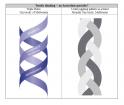Three is a general purpose interest of embodied minds
[ by Charles Cameron — threes in knotting, braiding, math and bell ringing — in service to governance, and the recognition of pattern within complexity ]
.
One is one and all alone and ever more shall be so..
Two is both duel and duet..
and three:

**
Well, those are knots, of the Celtic variety. I cam across those images because Tony Judge pointed me to the animations in a piece he’d written, Exploring Representation of the Tao in 3D: Virtual reality clues to reconciling radical differences, global and otherwise? —
which gets me thinking about thinking in threes —

— which has been an interest of mine for some time, see below —
**
And as is always the case with Judge‘s offerings, a plethora of his links called to me, and I wound up taking a look at his paper, Governance as “juggling” — Juggling as “governance”: Dynamics of braiding incommensurable insights for sustainable governance
— incommensurable insights is another topic of considerable interest to me —
— and that in turn brought me to this illustration of two instances of triple thinking about incommensurables from Australia — a triple helix and braiding:

**
Which brings us in turn to Borromean Rings and Knots:

Now the question to consider with each and all of these illustrations of threeness is whether they trigger any thoughts about the juggling and hopefully braiding and balancing of incommensurable forces in governance.. okay?
**
You’ll have noted that the braiding illustration from the Australian double illustration above is a representation of a juggling pattern. Wikimedia has dozens of such patterns with various numbers of balls, heights to which they are lobbed, &c, — and they’re fascinatingly eye-catching — mesmerizing, in fact.
Take a look at just three of them:


href="https://commons.wikimedia.org/wiki/File:3-ball_Mills_mess.gif">
>
Selection of animations of 3-ball juggling patterns by one juggler
(derived from juggling patterns in Wikipedia)
**
I mean:
**
Wow, and okay:
Now if a pattern of juggling can be represented as a pattern of braiding, we have a comparable situation to Ada Countess of Lovelace‘s brilliant cross-disciplinary leap of insight that the logical patterns Charles Babbage used to program for his proto-computing Analytical Engine could be represented in the punched cards used by Jacquard looms in the production of patterned fabrics:

**
Am I — is Tony Judge — are we — out on a limb?
Judge offers documentation of the mathematical side of things here:
Page 1 of 3 | Next page